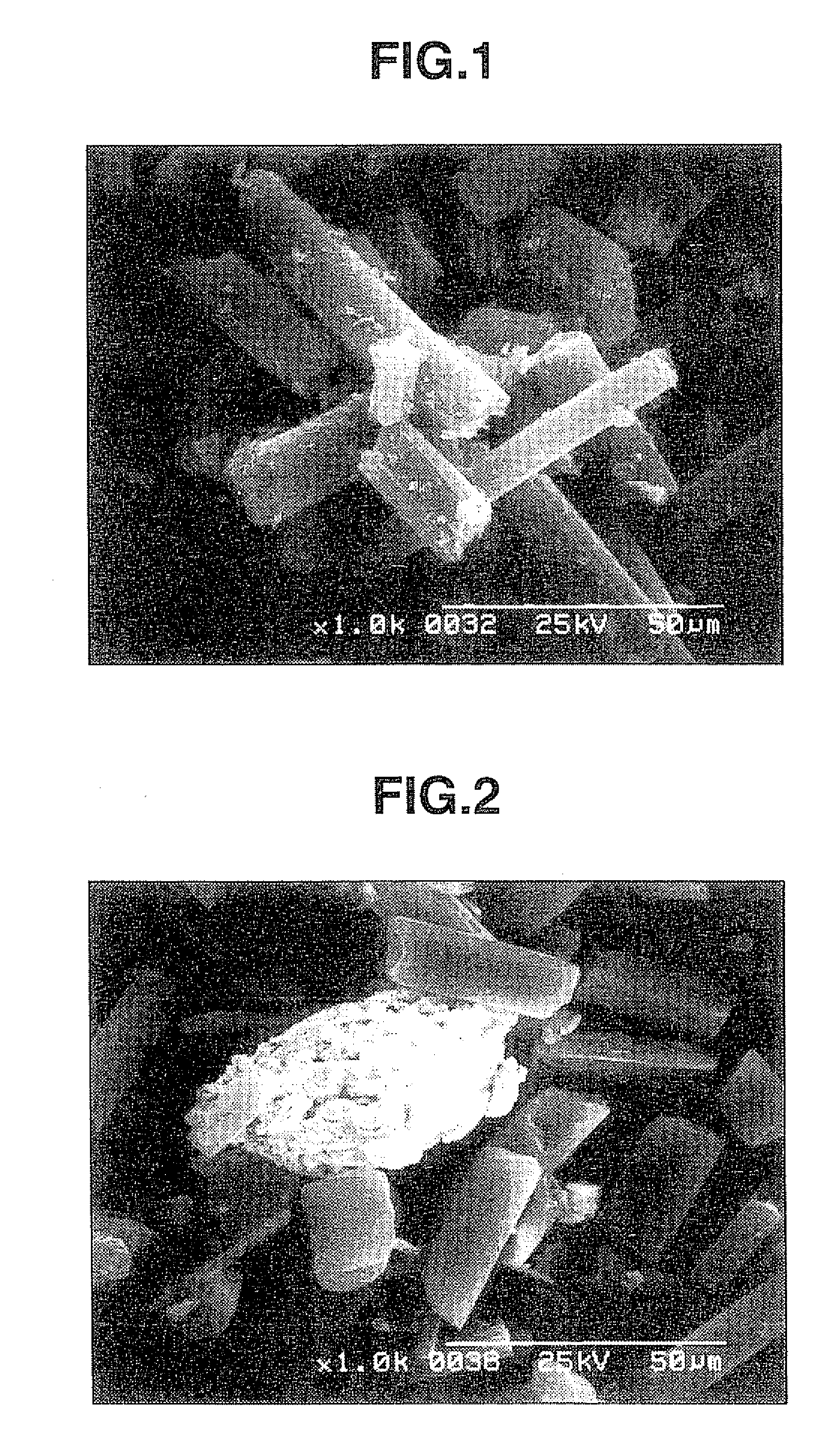Battery active material powder mixture, electrode composition for batteries, secondary cell electrode, secondary cell, carbonaceous material powder mixture for electrical double-layer capacitors, polarizable electrode composition, polarizable electrode, and electrical double-layer capacitor
a carbonaceous material and active material technology, applied in the field of battery active materials, can solve the problems of difficult to achieve sufficient contact between the active material powder and the carbon material, and the electrode material is difficult to provide a sufficient contact surface area, so as to enhance the rate capability of the battery and reduce the impedance of the electrode. , the effect of enhancing the power density
- Summary
- Abstract
- Description
- Claims
- Application Information
AI Technical Summary
Benefits of technology
Problems solved by technology
Method used
Image
Examples
synthesis example 1
Synthesis of Unsaturated Polyurethane Compound
[0260] A reactor equipped with a stirrer, a thermometer and a condenser was charged with 870 parts by weight of dehydrated ethylene oxide (EO) / propylene oxide (PO) random copolymer diol (molar ratio of EO / PO=7 / 3) having a hydroxyl number of 36.1, 107.4 parts by weight of 4,4′-diphenylmethane diisocyanate, and 100 parts by weight of methyl ethyl ketone as the solvent. These ingredients were stirred and thereby mixed for 3 hours at 80° C., giving a polyurethane prepolymer with isocyanate end groups.
[0261] Next, the entire reactor was cooled to 50° C., then 0.3 part by weight of benzoquinone, 5 parts by weight of dibutyltin laurate, 16.3 parts by weight of hydroxyethyl is acrylate and 6.3 parts by weight of 1,4-butanediol were added, and the ingredients were reacted at 50° C. for 3 hours. The methyl ethyl ketone was subsequently removed under a vacuum, yielding an unsaturated polyurethane compound.
[0262] The weight-average molecular weig...
synthesis example 2
Synthesis of Cellulose Derivative
[0263] Eight grams of hydroxypropyl cellulose (molar substitution, 4.65; product of Nippon Soda Co., Ltd.) was suspended in 400 mL of acrylonitrile, following which 1 mL of 4 wt % aqueous sodium hydroxide was added and the mixture was stirred 4 hours at 30° C.
[0264] The reaction mixture was then neutralized with acetic acid and poured into a large amount of methanol, giving cyanoethylated hydroxypropyl cellulose.
[0265] To remove the impurities, the cyanoethylated hydroxypropyl cellulose was dissolved in acetone, following which the solution was placed in a dialysis membrane tube and purified by dialysis using ion-exchanged water. The cyanoethylated hydroxypropyl cellulose which settled out during dialysis was collected and dried.
[0266] Elemental analysis of the resulting cyanoethylated hydroxypropyl cellulose indicated a nitrogen content of 7.3 wt %. Based on this value, the proportion of the hydroxyl groups on the hydroxypropyl cellulose that we...
synthesis example 3
Synthesis of Polyglycidol Derivative
[0267] A glycidol-containing flask was charged with methylene chloride as the solvent to a glycidol concentration of 4.2 mol / L, and the reaction temperature was set at −10° C.
[0268] Trifluoroborate diethyl etherate (BF3.OEt2) was added as the catalyst (reaction initiator) to a concentration of 1.2×10−2 mol / L, and the reaction was carried out by stirring for 3 hours under a stream of nitrogen. Following reaction completion, methanol was added to stop the reaction, after which the methanol and methylene chloride were removed by distillation in a vacuum.
[0269] The resulting crude polymer was dissolved in water and neutralized with sodium hydrogen carbonate, after which the solution was passed through a column packed with an ion-exchange resin (produced by Organo Corporation under the trade name Amberlite IRC-76). The eluate was passed through 5C filter paper, the resulting filtrate was distilled in vacuo, and the residue from distillation was drie...
PUM
| Property | Measurement | Unit |
|---|---|---|
| particle size | aaaaa | aaaaa |
| particle size | aaaaa | aaaaa |
| packing density | aaaaa | aaaaa |
Abstract
Description
Claims
Application Information
 Login to View More
Login to View More - R&D
- Intellectual Property
- Life Sciences
- Materials
- Tech Scout
- Unparalleled Data Quality
- Higher Quality Content
- 60% Fewer Hallucinations
Browse by: Latest US Patents, China's latest patents, Technical Efficacy Thesaurus, Application Domain, Technology Topic, Popular Technical Reports.
© 2025 PatSnap. All rights reserved.Legal|Privacy policy|Modern Slavery Act Transparency Statement|Sitemap|About US| Contact US: help@patsnap.com



